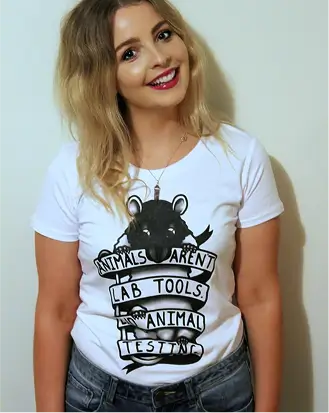Warning: Some of the information on this page includes disturbing content.
Horrific things have been done to animals for testing cosmetics and household products.
These cruel tests are completely unnecessary and many companies are choosing to skip animal testing altogether – like all the companies on our Cruelty Free Guide.
WHAT ANIMALS ARE USED?
All sorts of animals can be used in animal experiments, from armadillos to zebrafish. For cosmetics and household products, some of the most common animals used include rabbits, guinea pigs, rats, and mice.
WHAT TESTS ARE USED?
Examples of the types of tests that are conducted for cosmetics and household products include:
Toxicity testing
Toxicity testing involves an attempt to poison the animal with the substance, to assess what negative effects it might have on that animal.
Toxicity testing can be:
- Acute (happens over a short period).
- Chronic (happens over a long period).
- Aimed at the offspring of the animal rather than the animal itself (reproductive toxicity).
These tests can involve forcing the substance down the animal’s throat with a syringe, and they may experience diarrhea, convulsions, bleeding from the mouth, seizures, paralysis, and ultimately, death.
For dermal (skin) toxicity, the substance is instead applied to a shaved area of skin. Enough is applied to kill the animal via its toxic effects within two weeks.
For inhalation toxicity, rats can be locked in full-body restraint tubes and forced to inhale the substance. They may experience bleeding of the nose, convulsions, paralysis, and seizures before death.
These same tests can be drawn out over a longer period to investigate the effects over time. This can last a year or longer.
In reproductive tests, generations of animals can be subjected to the same effect – a mother is exposed to the chemicals for a period before birth, and then her children can be exposed throughout their lives. The ones that survive have the same treatment applied to their children.
Developmental toxicity can be similar, but instead involves killing the mother just before birth to examine the development of her children.
For genetic toxicity or ‘mutagenicity’ testing, samples of bone marrow and/or blood are examined for genetic changes.
In all cases, these animals are exposed unnecessarily to horrific experiences for cosmetics and household products.
Irritancy and corrosion testing
Irritation is reversible damage (such as a rash), while corrosion is permanent damage (such as a bad chemical burn). These tests are conducted on skin and eyes.
For skin sensitization testing, chemicals can be applied to the skin or injected under the skin of animals like guinea pigs or mice. The animals may show signs of redness, ulcers, scaling, inflammation, and itchiness.
Skin irritation and corrosion tests are often conducted on rabbits, with the substance being applied to shaved skin. Their skin can experience redness, rash, lesions, scaling, inflammation, and/or other signs of damage. This damage can be permanent.
Eye irritation and corrosion tests are also often conducted on rabbits. Their eyes may show signs of redness, bleeding, ulcers, blindness, and/or other signs of damage. This damage can be permanent.
Other tests
Other tests can include toxicokinetics or carcinogenicity.
Toxicokinetics investigates how the substance moves through the animal’s body. It involves testing like the tests listed above, but then blood samples are monitored to see how the substance progresses through the body.
Carcinogenicity investigates cancer-causing properties of a substance. It's commonly done on rats and mice, and can involve exposure through skin contact, force-feeding, forced inhalation, or other methods. After two years of daily exposure, they are killed and dissected.
WHAT ELSE CAN COMPANIES DO?
The first thing to understand is that other animals are not an accurate model for humans. Every species is different, and a rat cannot represent a human – or a rabbit or a guinea pig for that matter! We are simply different species, and our bodies behave differently when exposed to a substance.
There are many animal-free methods that can be used to give safe and accurate data without the use of animals.
Simple methods involve the use of willing human volunteers in ethical trials, which is both safe and effective.
More sophisticated methods involve recreating human skin from real-life human cells. A great example of this is Episkin...
EPISKIN -A SUPERIOR ANIMAL-FREE TEST
Episkin is made by culturing human skin cells to create a three-dimensional model that mimics the structure and function of human skin.
This can be used to replace the notorious Draize Test (an archaic animal test where substances are forced into the eyes or onto the skin of rabbits).
Episkin is more accurate at predicting human reactions: Episkin has a success rate of 70% whereas the success rate of the Draize Test is much lower at 56% which is very close to the odds of flipping a coin!1
LEARN MORE
- Find out more about animal-free test methods here.
- More info on the types of testing used for cosmetics and household products can be found on the Humane Society International website.





